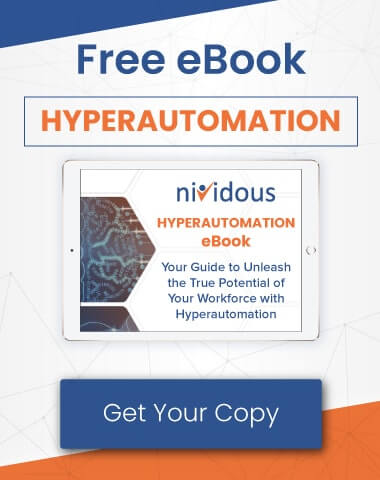Healthcare providers are burdened with complex processes and extensively customized systems that are obsolete and discrete. Manual management of these processes causes inefficiencies.
“Automation serves a key role in healthcare digital transformation by freeing resources for innovations that drive outcomes and health value,” Per Gartner.
In this blog, we will talk about Gartner’s recommended strategic automation decision framework that offers a roadmap and business case for healthcare CIOs to build their digital transformation journey from Robotic Process Automation (RPA) to Artificial intelligence (AI) to Hyperautomation.
This framework that covers the following key aspects essentially offers a strategic path to achieve successful digital transformation in healthcare:
- Ways to identify automation opportunities
- Understanding the difference between RPA, AI, and Hyperautomation
- Estimating ROI to strengthen your business case
- Evaluating vendors against must-meet criteria
Identifying Automation Opportunities
The foremost thing to identify automation opportunities in your organization is to assess the business process characteristics by asking questions such as:
- Does the process involve structured or unstructured data?
- Does the process change frequently?
- Does it run on specified rules or human judgments?
- Is packaged commercial off-the-shelf software available that can accomplish this process without customized scripts?
- Is this process a candidate for reengineering?
- Are there specific success criteria that indicate process completion?
This list of questions will help you in selecting the most suitable processes for automation. To expedite digital transformation in healthcare, using the above set of questions, leaders should automate as many tasks as possible so that their human staff is freed up to focus on providing better patient care. For example, think of all the manual efforts of skilled resources that go to administrative tasks: record-keeping, insurance authorizations, medical coding, and billing. Further, check the graphic below that details many other tasks that are prime candidates for automation.

Claims Management

Patient Assistance

Data Migration

Vendor Management

Fraud Prevention

Overpayment Reconciliation

Data Cleansing

Customer Complaints

Drug Registration

Patient Registration

Reporting

Administration
All of these tasks can be fully or partially automated—the scope of automation will depend on your choice of automation technology and the way you combine it with the other complementary tools to achieve end-to-end automation. Let us understand these technologies that have proven capabilities to deliver true digital transformation in healthcare.
Understanding RPA, AI, And Hyperautomation
What Is RPA?
Robotic Process Automation (RPA) is the use of software robots, or “bots,” to complete repetitive, rules-based tasks within or between computer systems. It is a software solution for simple, tedious tasks; it is a digital labor-saving tool; it is the key to freeing staff for higher-level activities.
What Is AI?
AI brings in the human-like decision-making to offload some more manual yet complex work from your employees that RPA alone cannot do. With AI, machines are capable of learning from large stores of data. They can use that learning to make decisions—a form of “thinking.” These AI capabilities allow computers to solve real-life problems, rather than formal, rule-based problems.
AI and RPA together can help businesses to move from siloed automation towards end-to-end automation and greatly expand the scope of automation possibilities. This combination drives better operational efficiency providing more opportunities to automate at scale.
Here is a detailed blog post on how RPA and AI are different and when they can be used together?
What Is Hyperautomation?
“Hyperautomation involves the orchestrated use of multiple technologies, tools, or platforms, such as AI, ML, event-driven software architecture, RPA, iPaaS, packaged software, and other decision or task automation tools. This combination augments humans’ capabilities, allowing them to complete processes faster, more efficiently and with fewer errors.” Per Gartner
[Source: Strategic Automation Decision Framework: From RPA to AI on the Journey to Hyperautomation in Healthcare, Mandi Bishop, 14 December 2020]
The term “hyperautomation” was coined by Gartner as one of the year’s top 10 strategic technology trends. Hyperautomation, a more disciplined approach towards business results, allows you to combine complementary technologies such as RPA, AI, Machine Learning (ML), Business Process Management (BPM), process mining, and other types of decision and task automation tools to automate more processes end-to-end. With Hyperautomation, you can automate tasks quickly and often at a scale that delivers value that has a lasting impact on the overall business.
Want to learn more about Hyperautomation?
Watch the on-demand webinar about hyperautomation and its benefits.
Estimating Automation RoI To Strengthen Your Business Case
The immediate ROI achieved through early success of POCs and Pilots is a good way to estimate short-term gains, but you must establish smart goals for each project to execute the roadmap beyond POCs.
Start lean with easy to automate candidate processes aligned with high-value KPIs to get momentum and set specific targets.
Healthcare payers often use the cost per claim processed metric. It is a good example of a significant opportunity for quick efficiency gains, resulting in accelerated ROI realization and long-term savings.
Per Gartner, “Claims requiring human intervention cost about $4 to process, and auto adjudicated claims cost $1 to process. Manual rework costs $25 per claim to process. With more than 3 billion claims processed in the U.S. per year, the savings opportunity is compelling.”
Use this free Nividous RoI calculator tool to estimate ROI for your automation project and get a detailed report in return that includes:
- ROI and savings estimates on monthly, quarterly, and yearly terms
- ROI comparisons between the Nividous platform and competing RPA providers
- Our full Complexity Vs. Value matrix, plus more information on prioritizing tasks for automation
Evaluating Automation Vendors Against Must-Meet Criteria
It is difficult to find a single vendor with deep expertise for each technology within the Hyperautomation umbrella. So, it is important to prioritize your list of use cases and goals and ask specific questions to the prospective vendors. Gartner recommends the following questions”
- “Define RPA, ML, IA and AI. Demonstrate how the product uses each (if applicable).
- Demonstrate product configuration, including the programming required to develop scripts or algorithms
- Provide production results with named client references for specific processes under consideration (such as claims edits or general ledger data entry).
- For IA and AI, describe outcome improvements attributed to algorithms and analytics rather than human intervention through code modification.
- Provide a time frame for initial code development or product configuration, as well as intelligence model changes and maintenance.”
Your Journey From RPA To AI To Hyperautomation On The Nividous Platform
Artificial Intelligence combined with Robotic Process Automation and Business Process Management leads to Hyperautomation, in which a robust digital tool like the Nividous platform automates both individual tasks and complete, end-to-end processes, orchestrating work between RPA bots and the human workforce. Here are a few examples of Nividous Hyperautomation platform in the healthcare industry:
- The medical coding and billing process is costly and time-consuming. Nividous’ customer Kane Wound Care, a major wound care company in the US used Nividous’ smart Bots to automate its coding and billing processes, leading to a 95% reduction in manual work, and turnaround-time improvement of 85%. Read the case study.
- AEG Vision, Nividous’ customer in the healthcare domain revolutionized its complete revenue cycle management making the Nividous platform a standardized platform to handle automated claims benefits verification, claim submissions, posting and reconciliation as well as aged claims adjustments. Read the case study.
- A leading specialty healthcare company leveraged the Nividous platform to automate patient data extraction and review. With Hyperautomation, this provider achieved a 45% reduction in operational costs and an 80% reduction in the manual patient data processing. Read the case study.
Accelerating digital transformation in healthcare is just one step away.
Contact Nividous to address your unique business challenges—and find the automation solution of your choice.




![The Path Forward for Intelligent Automation [2024 Trends] Blog Feature](https://nividous.com/wp-content/uploads/2024/05/The-Path-Forward-for-Intelligent-Automation-blog-feature-1.webp)
